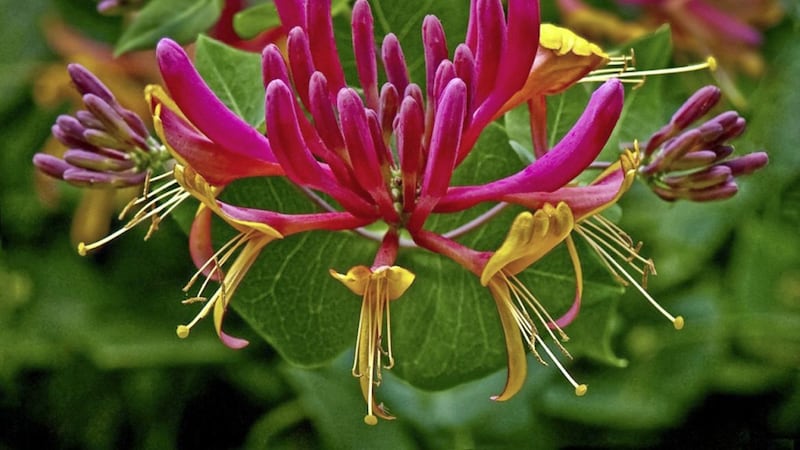THE number of gardeners who stubbornly refuse to utilise climbers never fails to surprise me. When you consider the variety of foliage, colour, texture, scents and blooms they offer, there really is no excuse for not thinking vertically.
A handful of healthy climbers will take your garden to another dimension, while simultaneously softening hard surfaces or hiding unsightly features. Even if you don’t want to break up that expansive gable end or shield an ugly oil tank, you should still consider incorporating some climbers into your planting scheme.
To a lesser and greater degree, climbers require some sort of support on which to grow, such as a trellis, wires or an existing tree or shrub. Unable to produce thick self-supporting trunks and defy gravity unaided, this varied collection of plants has developed numerous methods of securing a leg-up from their host.
Species such as Virginia creeper use adhesive pads to cling to hard vertical surfaces, while a climbing rose will only remain upright if its thorns are well hooked onto a support.
When deciding which climbers to choose, consider what their purpose will be – is it for instance designed to be purely decorative or will it be masking another part of the garden? Some species may provide great floral displays at the height of summer, yet look withered and failing for six months of the year, so if it’s sustained structure you’re after it’s best to choose evergreen foliage over flowers.
Supported by trellis, the often-maligned Russian vine – or ‘mile-a-minute’ – can provide a thick barrier, even after losing its leaves. However, as its name suggests, it boasts a vigorous growth rate and can easily overwhelm other climbers or trees that it encounters. Sited too close to a perimeter fence or wall and it could well end up intruding into your neighbour’s garden.
Ivies and the aforementioned Virginia creeper are the two most popular choices for colonising an expansive wall. The former comes in a variety of shades and gives year-round colour, while the latter loses its leaves in late autumn, leaving an impressive skeletal network of stalks across its host surface.
One climber that’s often overlooked by gardeners is actually one of Ireland’s commonest. Walk along any rural hedgerow at dusk in July and it won’t be long before your nostrils are filled with the sweet, heady fragrance of the native honeysuckle (Lonicera periclymenum).
The beguiling perfume is aimed not at humans but at moths, though its popularity is down to both – the former utilising it as a garden plant, the latter feeding on the flowers’ sweet nectar and pollinating them in the process.
In the wild, the plant Shakespeare called "luscious woodbine" in a Midsummer Night’s Dream, scrambles through other trees and shrubs, its long stems often stretching high into the canopy. It will also twist itself around young saplings, forcing the trunk of its host to grow in a spiral, creating the sought-after corkscrew wood from which novelty walking sticks are fashioned.
There are nearly 200 species of honeysuckle to choose from, a significant number of which lack any notable scent. A recommended cultivar is Lonicera periclymenum ‘Graham Thomas’, which has creamy-yellow flowers that bloom most of summer before making way for bright red berries.
‘Belgica’ aka ‘Early Dutch’ is the earliest honeysuckle to flower and boasts a rich perfume. While the idea of non-fragrant honeysuckles may be anathema, in the case of the hybrid Lonicera. x tellmanniana and ‘Dropmore Scarlet’ their colour is enough of a selling point.








